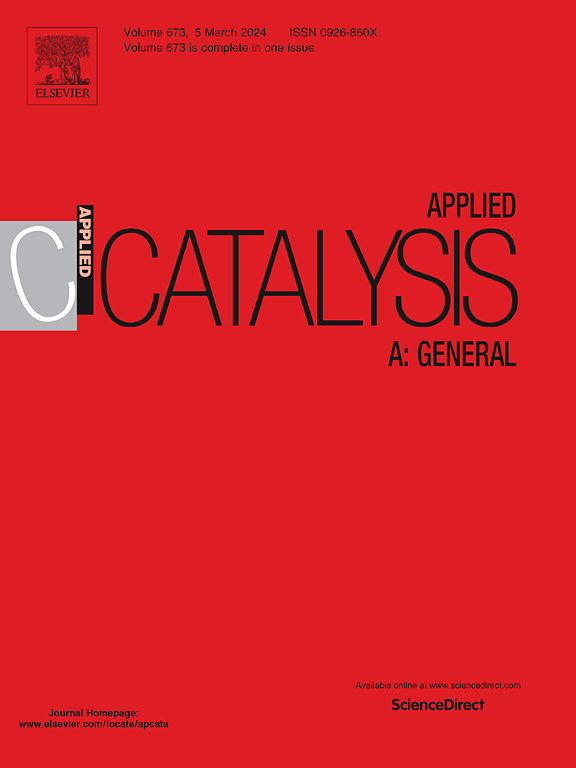CO2选择性加氢制乙醇CuFeZn催化剂中Fe5C2与Cu协同作用机理研究
IF 4.8
2区 化学
Q2 CHEMISTRY, PHYSICAL
引用次数: 0
摘要
CuFeZn催化剂催化CO2加氢制乙醇是一项很有前途的技术。本研究利用周期密度泛函理论(DFT)系统地研究了CuFeZn模型催化剂上CO2加氢制乙醇的机理,重点研究了CO2加氢的关键步骤。计算表明,CO*的形成对于CH3CH2OH的生成至关重要,这需要克服1.91 eV的能垒。CO*与CH3*的偶联是决定反应速率的步骤,需要克服2.77 eV的能垒。进一步分析表明,CuFeZn催化剂的协同效应显著影响CO2活化和CO*与CH3*的偶联反应,从而促进CH3CH2OH的生成。CuFeZn催化剂的高催化性能是由于活性Fe5C2与Cu之间的协同作用。态密度(DOS)和电子定位函数(ELF)分析表明,Fe5C2中Cu d带中心的升高和FeⅣ的高电子定位促进了CO*的形成,从而促进了乙醇的合成。综上所述,利用多种活性组分调节CO*的生成及其与CH3*偶联的活化屏障,可以显著提高乙醇的选择性生产。该研究强调了CuFeZn催化剂在CO2加氢制乙醇中的重要作用,为未来催化剂的设计和优化提供了有价值的理论见解。本文章由计算机程序翻译,如有差异,请以英文原文为准。
Mechanism investigation on the synergistic effect between Fe5C2 and Cu in CuFeZn catalysts for the selective hydrogenation of CO2 to ethanol
As a promising technology, the selective hydrogenation of CO2 to ethanol using CuFeZn catalysts has attracted significant attention. This study systematically investigates the mechanism of the hydrogenation of CO2 to ethanol over the CuFeZn model catalyst using periodic density functional theory (DFT), with particular focus on the key steps in CO2 hydrogenation. The calculations indicate that the formation of the CO* species is crucial for the production of CH3CH2OH, which requires overcoming an energy barrier of 1.91 eV. The coupling of CO* with CH3* is the rate-determining step, which involves overcoming an energy barrier of 2.77 eV. Further analysis shows that the CuFeZn catalyst’s synergistic effect significantly influences CO2 activation and the coupling reaction between CO* and CH3*, thereby enhancing CH3CH2OH formation. The high catalytic performance of the CuFeZn catalyst is attributed to the synergistic interactions between the active Fe5C2 and Cu. Density of States (DOS) and Electronic Localization Function (ELF) analyses show that the elevated Cu d-band center and the high electronic localization of FeⅣ in Fe5C2 enhance the formation of CO* species, thus promoting ethanol synthesis. In summary, by utilizing multiple active components to modulate the generation of CO* species and their activation barriers for coupling with CH3*, the selective production of ethanol can be significantly improved. This study underscores the crucial role of the CuFeZn catalyst for CO2 hydrogenation to ethanol, providing valuable theoretical insights for future catalyst design and optimization.
求助全文
通过发布文献求助,成功后即可免费获取论文全文。
去求助
来源期刊

Applied Catalysis A: General
化学-环境科学
CiteScore
9.00
自引率
5.50%
发文量
415
审稿时长
24 days
期刊介绍:
Applied Catalysis A: General publishes original papers on all aspects of catalysis of basic and practical interest to chemical scientists in both industrial and academic fields, with an emphasis onnew understanding of catalysts and catalytic reactions, new catalytic materials, new techniques, and new processes, especially those that have potential practical implications.
Papers that report results of a thorough study or optimization of systems or processes that are well understood, widely studied, or minor variations of known ones are discouraged. Authors should include statements in a separate section "Justification for Publication" of how the manuscript fits the scope of the journal in the cover letter to the editors. Submissions without such justification will be rejected without review.
 求助内容:
求助内容: 应助结果提醒方式:
应助结果提醒方式:


